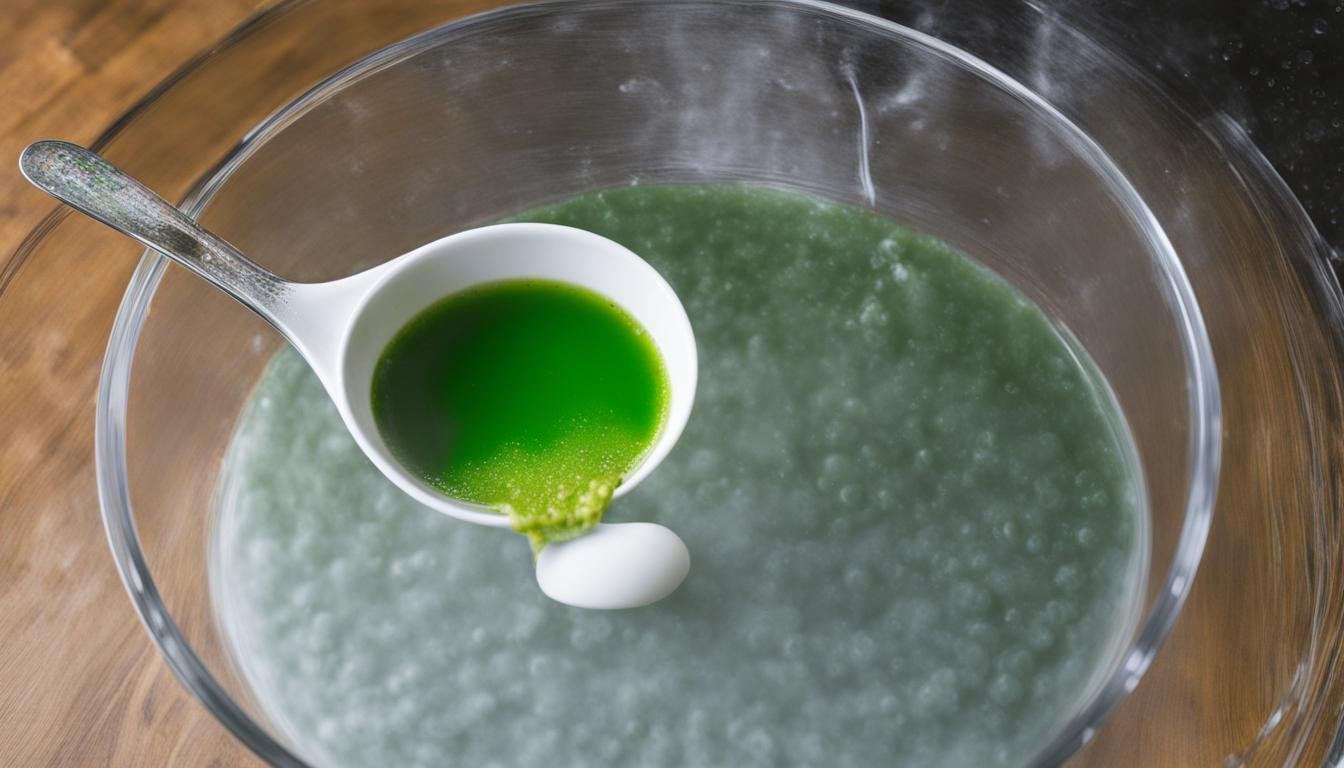
When and How to Use Sodium Alginate in Your Food Product
SUBSCRIBE TO OUR BLOG
Promotions, new products, and recipes.
If you work in the food industry, you're likely familiar with sodium alginate - a versatile ingredient that's commonly used as a food thickener and gelling agent. But do you understand the intricacies of its properties and how to best incorporate it into your food formulations?
In this article, we'll explore the world of sodium alginate and provide practical guidance on how to use it to improve the texture, stability, and overall quality of your food products. We'll discuss its benefits and applications, while also highlighting the importance of using it correctly to achieve optimal results.
Key Takeaways
- Sodium alginate is a versatile food ingredient with unique properties
- It functions as a food thickener and gelling agent
- The correct dosage and mixing techniques are crucial when incorporating sodium alginate into food formulations
- It can enhance texture and stability while also improving shelf life
- Sodium alginate is particularly well-suited for use in specific food categories
Understanding Sodium Alginate: A Versatile Food Ingredient
Sodium alginate is a natural polysaccharide that is extracted from brown seaweed and has a wide range of applications in the food industry. It is commonly used as a thickener, gelling agent, and emulsifier due to its unique properties.
Alginate is a linear copolymer consisting of two monomers: β-D-mannuronic acid (M) and α-L-guluronic acid (G), which are arranged in various block sequences. The properties of sodium alginate depend on the composition of these blocks, their lengths, and their distribution.
Sodium alginate easily dissolves in water, forming a viscous solution that can be manipulated to create gels and films. Its gelling properties are influenced by several factors, including pH, temperature, and the presence of divalent cations such as calcium ions.
Sodium Alginate Properties
The properties of sodium alginate make it a versatile ingredient in the food industry. It can be used to create a range of textures, from viscous liquids to firm gels, and can improve the stability and shelf life of products. Sodium alginate can also enhance the sensory experience of products because of its ability to control the release of flavors and fragrances.
Furthermore, sodium alginate is a vegan-friendly alternative to gelatin, a commonly used thickening and gelling agent that is derived from animal collagen. Sodium alginate is also heat-stable, making it suitable for use in cooked and baked products.
"Sodium alginate is an excellent hydrocolloid for creating gels, providing a smooth and consistent texture, and stabilizing formulations."
Applications of Sodium Alginate in the Food Industry
Sodium alginate is a versatile food ingredient that finds numerous applications in the food industry. Its unique properties, including its ability to thicken and gel, make it a desirable ingredient in many food formulations.
One of the most common uses of sodium alginate is in the production of processed meat products such as sausages and patties. It is used as a binder to hold the meat together and improve texture and moisture retention.
Sodium alginate is also used in the production of dairy products such as ice cream and yogurt. It stabilizes the products, preventing the separation of water and other ingredients. This results in a creamier and more consistent texture.
| Food Product | Sodium Alginate Application |
|---|---|
| Bakery products | Improves texture and shelf life |
| Jellies and desserts | Provides a stable gel and enhances texture |
| Canned foods | Improves water retention and texture |
| Sauces and dressings | Enhances viscosity and stability |
Sodium alginate is also commonly used in the production of vegetarian and vegan food products. It is an effective substitute for animal-based ingredients such as gelatin, providing similar textural properties without using animal products.
The pharmaceutical industry also utilizes sodium alginate as an encapsulating agent for medication. This allows for controlled release of the drug and improved absorption by the body.
Overall, the applications of sodium alginate in the food industry are vast and varied. Its versatility and unique properties make it a valuable ingredient in many different types of food products.
Incorporating Sodium Alginate in Food Formulations
When using sodium alginate as a food ingredient, it is important to consider the appropriate dosage, mixing techniques, and other factors that can affect the final texture and stability of the product. Here are some key steps to follow when incorporating sodium alginate in food formulations:
- Determine the appropriate dosage: The recommended amount of sodium alginate to use in a food product will depend on the specific application and desired texture. Generally, a concentration of 0.5-1.5% of sodium alginate in the total formulation is sufficient to achieve the desired thickening or gelling effect. However, it is important to test and adjust the dosage as needed, as too much sodium alginate can result in a rubbery or slimy texture in the final product.
- Mix sodium alginate with other dry ingredients: To ensure even distribution of sodium alginate in the food product, it is recommended to mix it with other dry ingredients before adding any liquids. This will help prevent clumping or uneven dispersion of the alginate powder.
- Hydrate sodium alginate in water: Sodium alginate needs to be hydrated in water before adding it to the food product. This can be done by sprinkling the alginate powder over the surface of cold water and whisking vigorously until fully dispersed. The mixture should then be left to hydrate for at least 15-30 minutes before adding it to the other ingredients.
- Combine sodium alginate mixture with other ingredients: Once the sodium alginate has been hydrated, it can be added to the food product along with other ingredients, such as sugar or salt. It is important to mix the ingredients thoroughly to ensure even dispersion of the alginate and avoid any clumping or separation of the product.
- Avoid excessive heat: Sodium alginate can lose its thickening or gelling properties if exposed to excessive heat. It is important to avoid boiling or heating the food product to high temperatures after adding the alginate mixture. Instead, it is recommended to cook the food product at a low to medium heat to avoid denaturing the alginate and compromising its functionality.
Try Sodium Alginate for Yourself
Now you can try it for yourself. Pick up a packet of Cape Crystal Brands Sodium Alginate below.
Considerations for Optimal Results
To ensure optimal results when incorporating sodium alginate in food formulations, it is important to consider the following factors:
- pH level: Sodium alginate is most effective in a pH range of 4-9. If the pH level of the food product is too low or too high, it may affect the functionality of the alginate and result in an undesirable texture.
- Temperature: As mentioned earlier, excessive heat can denature the sodium alginate and compromise its functionality. It is important to monitor the temperature of the food product and avoid exposing it to high temperatures.
- Mixing: Proper mixing of the sodium alginate with other ingredients can help ensure even dispersion and prevent clumping or separation in the final product. It is recommended to mix the ingredients thoroughly and avoid overmixing, which can also affect the final texture.
Benefits of Sodium Alginate in Food Products
Sodium alginate is a versatile food ingredient that offers many benefits when incorporated into food products. Here are some of the key advantages:
- Enhanced Texture: Sodium alginate can improve the texture of food products by creating a smooth, creamy consistency. This is particularly useful in products such as sauces, dressings, and dips.
- Improved Stability: Sodium alginate can improve the stability and shelf life of food products by preventing separation and maintaining a uniform consistency. This is particularly useful in products such as ice cream and other frozen desserts.
- Better Mouthfeel: Sodium alginate can enhance the mouthfeel of food products by creating a pleasing, chewy texture. This is particularly useful in products such as baked goods and confectionery.
- Reduction of Fat: Sodium alginate can be used to reduce the fat content in certain food products without compromising on texture or flavor. This is particularly useful in products such as dairy-based desserts and snacks.
- Increases Nutritional Value: Sodium alginate is a natural source of dietary fiber, which can help increase the nutritional value of food products. This is particularly useful in products such as bread and cereal bars.
"Sodium alginate is an ingredient that can provide a range of benefits to food products, from improving texture and stability to reducing fat and increasing nutritional value."
Overall, incorporating sodium alginate in your food product can lead to a better consumer experience and increased marketability. Experimenting with different formulations and dosage levels can help achieve the desired result in your food product.
Sodium Alginate as a Hydrocolloid: Exploring its Properties
Sodium Alginate is a hydrocolloid that is commonly used in the food industry for its ability to interact with water and other food ingredients to form gels. The properties of this versatile ingredient make it an ideal food thickener and gelling agent that can enhance the texture and stability of various food products.
One of the key properties of sodium alginate is its ability to form gels in the presence of calcium ions. When sodium alginate comes into contact with a calcium-rich solution, it forms a gel that can be used to stabilize emulsions and provide a desirable texture in food products.
The gelling properties of sodium alginate can be used to create a range of textures, from firm to delicate. The strength of the gel is dependent on the concentration of sodium alginate and calcium ions, as well as the pH and temperature of the solution.
Sodium Alginate is also highly soluble in water, which makes it easy to incorporate into food formulations. Its solubility allows for even dispersion throughout the product, ensuring consistent texture and stability.
In addition to its gelling and solubility properties, sodium alginate is also an effective thickener. Its ability to increase viscosity and control flow makes it an essential ingredient in many food products.
Overall, the hydrocolloid properties of sodium alginate make it an important ingredient in the food industry. Its ability to form gels, enhance texture and stability, and thicken food products make it an ideal ingredient for a wide range of food formulations.
Best Foods for Sodium Alginate Incorporation
If you're looking to enhance the texture and stability of your food products, sodium alginate could be just the ingredient you need. This versatile compound is particularly well-suited for certain types of foods, including:
- Dairy Products: Sodium alginate can be used to create a smooth, creamy texture in dairy products like ice cream, yogurt, and cheese. It can also help improve freeze-thaw stability and prevent the formation of ice crystals.
- Bakery Items: Sodium alginate can enhance the texture and shelf life of baked goods like bread, cakes, and pastries. It can also help improve dough elasticity and reduce breakage.
- Sauces and Dressings: Sodium alginate can be used as a thickening agent in sauces and dressings, providing a smooth, consistent texture. It can also help improve stability and prevent separation.
- Beverages: Sodium alginate can be used to improve the texture and mouthfeel of beverages like juice, smoothies, and protein shakes. It can also help improve stability and prevent sedimentation.
- Meat Products: Sodium alginate can be used to create a firmer texture in meat products like burgers, sausages, and deli meats. It can also help improve water retention and reduce cooking loss.
These are just a few examples of the many foods that can benefit from the incorporation of sodium alginate. By understanding the properties and applications of this versatile ingredient, you can take your food products to the next level.
Enhancing Food Texture and Stability with Sodium Alginate
Sodium alginate is a versatile ingredient that is widely used as a food thickener and gelling agent. Its unique properties make it an effective tool for enhancing texture and stability in various food products.
One of the main uses of sodium alginate is as a food thickener. When added to a liquid, it forms a gel that can be used to thicken sauces, soups, and other foods. This property is particularly useful for food manufacturers who want to achieve a consistent texture in their products.
Sodium alginate is also an effective gelling agent. When combined with calcium ions, it forms a gel that can be used to create a wide range of textures in foods. For example, sodium alginate can be used to create firm gels in products like jellies and jams, or soft gels in products like yogurt and ice cream.
One of the benefits of using sodium alginate as a food thickener and gelling agent is that it can improve the stability of food products. By creating a consistent texture and preventing separation of ingredients, sodium alginate can help extend the shelf life of foods.
Case Study
"A food manufacturer was struggling to achieve a consistent texture in their vegetable sauce product. By incorporating sodium alginate as a thickener, they were able to create a smooth, creamy texture that was consistent across all batches. This improved the overall quality of the product and increased customer satisfaction."
In conclusion, sodium alginate is a valuable tool for food manufacturers looking to improve the texture and stability of their products. Its unique properties as a food thickener and gelling agent make it a versatile ingredient that can be used in a wide range of applications.
Conclusion
Overall, the use of sodium alginate in the food industry has become increasingly prevalent due to its unique properties and versatile applications. Understanding the benefits and functions of this ingredient is crucial for achieving optimal results in food product formulations.
By utilizing sodium alginate as a food thickener and gelling agent, food manufacturers can enhance the texture and stability of their products. Incorporating sodium alginate in food formulations can also extend their shelf life and improve overall consumer experience.
While there are many food products that can benefit from the use of sodium alginate, it is important to consider dosage, mixing techniques, and other factors to ensure optimal results. Additionally, it is important to choose the right types of foods for incorporating sodium alginate to achieve the desired textural attributes.
As the food industry continues to evolve, the use of sodium alginate is likely to become even more prevalent. Therefore, it is important for food manufacturers to stay up-to-date on the latest developments in this area and to explore the potential applications of sodium alginate in their own product formulations.
FAQ
When and how should sodium alginate be used in food products?
Sodium alginate is best used as a food thickener and gelling agent. It should be incorporated into food formulations in recommended dosages and mixed thoroughly to achieve optimal results.
What are the properties of sodium alginate?
Sodium alginate is a versatile ingredient that enhances the texture and stability of food products. It functions as a hydrocolloid, interacting with water and other ingredients to form gels and provide desired textural attributes.
What are some applications of sodium alginate in the food industry?
Sodium alginate finds diverse applications in the food industry. It can be used in various food products to improve texture, stability, and shelf life. Examples include dairy products, sauces, dressings, and bakery items.
How can sodium alginate be incorporated into food formulations?
Sodium alginate should be added to food formulations following recommended dosage guidelines. It can be mixed into the desired food product using standard mixing techniques for optimal dispersion and functionality.
What are the benefits of using sodium alginate in food products?
Sodium alginate offers several benefits when incorporated into food products. It improves texture, stability, and overall quality. It also enhances shelf life and provides a better consumer experience.
Which types of foods are best suited for sodium alginate incorporation?
Sodium alginate can be effectively used in a wide range of food categories. It is particularly well-suited for dairy products, confections, dressings, and sauces due to its ability to improve texture and stability.
How does sodium alginate enhance food texture and stability?
Sodium alginate functions as a food thickener and gelling agent, enhancing texture and stability in various food products. It provides the desired viscosity and structure, resulting in improved product quality.
Well That's it. That was an insightful blog post Let's Hear Your Thoughts!
We've shared our insights, and now it's your turn! Have an opinion, a question, or a story to share about this article? Dive into the comments below and join the conversation. Your voice is a crucial part of this community, and we're eager to hear what you have to say.
We would appreciate hearing from you. Please add your comments below. We will reply to them.
See: The Hydrocolloid Glossary
For further reading:
Elevate Your Culinary Creations! 🍽️✨
Every dish deserves the perfect texture to complement its flavors. Why settle for anything less than perfection? With Cape Crystal Brands Food Texture products, you don't have to. Whether you're crafting velvety sauces, glistening gels, or fluffy mousses, our range ensures you get the consistency you desire every single time.
Don't just cook—create masterpieces. Dive into the world of culinary textures and elevate every meal. Shop now and experience the magic of Cape Crystal!
🛍️ Click Here to Explore Cape Crystal Brands Food Texture Products!

About the Editor
About the Chef Edmund: Chef Edmund is the Founder of Cape Crystal Brands and EnvironMolds. He is the author of several non-fiction “How-to” books, past publisher of the ArtMolds Journal Magazine and six cookbooks available for download on this site. He lives and breathes his food blogs as both writer and editor. You can follow him on Twitter and Linkedin.

- Choosing a selection results in a full page refresh.



